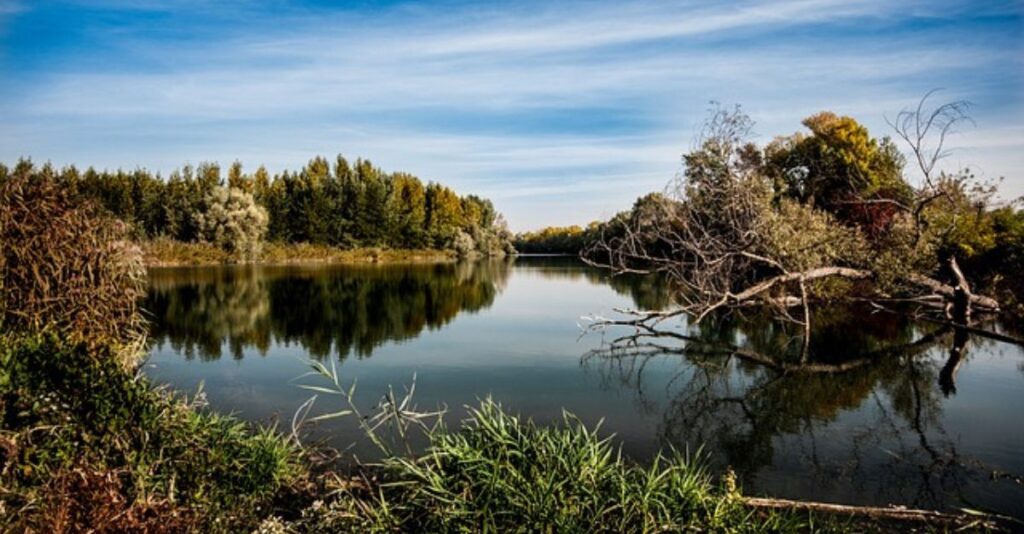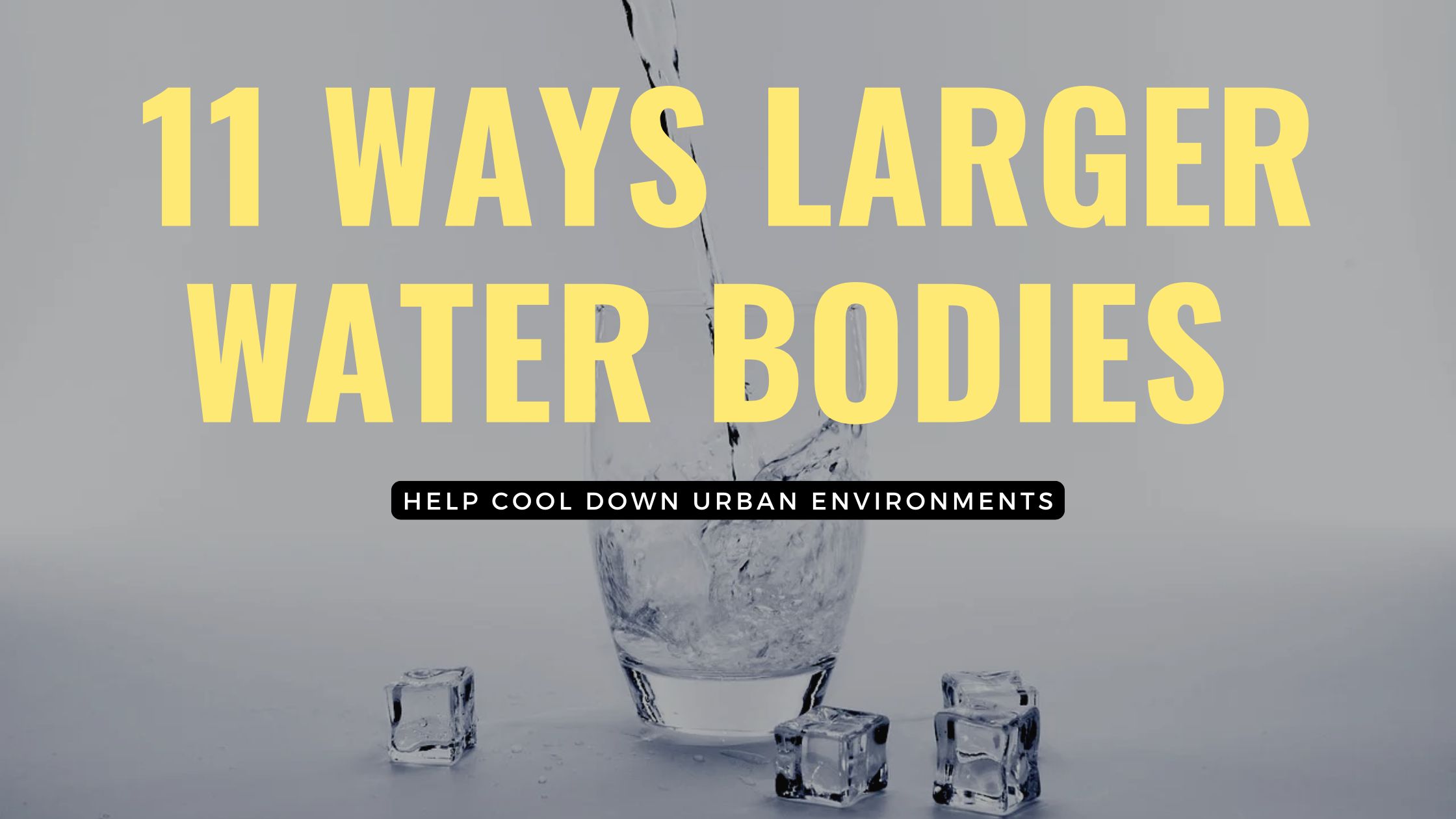Introduction:-
11 Ways Larger Water Bodies Help Cool Down Urban Environments
Urban areas often grapple with the heat island effect, where temperatures are significantly higher than in rural areas due to human activities and infrastructure. One effective way to mitigate this effect is by incorporating larger water bodies in urban planning. Here’s a look at how larger water bodies help cool down urban environments, along with tips, benefits, suggestions, and frequently asked questions.
11 Ways Larger Water Bodies Help Cool Down Urban Environments

1. Enhanced Air Circulation
Benefit: Larger water bodies improve air circulation by creating localized breezes, which help disperse heat in urban areas.
Tip: Design urban landscapes to maximize the exposure of water bodies to prevailing winds.
2. Evaporative Cooling
Benefit: Water bodies facilitate evaporative cooling, reducing ambient temperatures.
Tip: Position water features where they can be easily accessed by the public to increase the cooling effect.
3. Heat Absorption
Benefit: Water bodies absorb and store heat, releasing it slowly, which helps moderate temperature fluctuations.
Tip: Use materials that complement the cooling properties of water in nearby constructions.
4. Shading
Benefit: Vegetation around water bodies provides shade, further contributing to cooling.
Tip: Plant trees and shrubs around water bodies to enhance their cooling effect.
5. Reflectivity
Benefit: The reflective surface of water bodies reduces heat absorption by nearby structures.
Tip: Incorporate reflective materials and surfaces in the vicinity to amplify this effect.
6. Humidity Regulation
Benefit: Water bodies help maintain humidity levels, which can make the heat feel less oppressive.
Tip: Maintain clean and healthy water bodies to prevent the growth of harmful bacteria.
7. Social Gathering Spaces
Benefit: Water bodies create pleasant environments for social gatherings, encouraging outdoor activities and promoting a sense of community.
Tip: Design attractive waterfront areas with seating, walkways, and recreational facilities.
8. Biodiversity Support
Benefit: Water bodies support local biodiversity, creating habitats for various plant and animal species.
Tip: Incorporate native plants and sustainable practices to maintain ecological balance.
9. Aesthetic Appeal
Benefit: Water features enhance the aesthetic appeal of urban areas, increasing property values and attracting tourism.
Tip: Integrate artistic elements and lighting to create visually appealing water features.
10. Pollution Reduction
Benefit: Water bodies can help reduce air pollution by trapping dust and particulate matter.
Tip: Regularly clean and maintain water bodies to ensure they remain effective in pollution reduction.
11. Climate Resilience
Benefit: Incorporating water bodies makes urban areas more resilient to climate change by mitigating heat and providing emergency water sources.
Tip: Implement adaptive management practices to ensure water bodies remain functional and sustainable.
Suggestions
- Integrate Smart Water Management: Use smart technology to monitor and manage water bodies for optimal performance.
- Community Involvement: Engage the community in the maintenance and conservation of water bodies.
- Sustainable Design: Ensure that water bodies are designed with sustainability in mind to minimize environmental impact.
How can we enhance the cooling effect of water bodies in urban areas?

Enhancing the cooling effect of water bodies in urban areas can significantly improve the microclimate and overall comfort of residents. Here are some strategies to maximize this effect:
- Incorporate Vegetation:
- Plant Trees and Shrubs: Surround water bodies with trees and shrubs to provide additional shade and enhance evaporative cooling.
- Use Native Plants: Select native plant species that are well-suited to the local climate and require less maintenance.
- Design for Airflow:
- Orient Water Bodies to Prevailing Winds: Position water bodies to take advantage of prevailing winds, which can carry cool air through urban areas.
- Create Open Spaces: Design open spaces around water bodies to facilitate airflow and prevent obstruction by buildings.
- Enhance Surface Area:
- Use Multiple Smaller Water Features: Instead of one large water body, consider multiple smaller features (e.g., fountains, ponds) to increase the overall evaporative surface area.
- Incorporate Permeable Surfaces: Use permeable materials in surrounding areas to allow for better water infiltration and cooling.
- Integrate Smart Technology:
- Install Smart Water Management Systems: Use smart sensors and systems to monitor water levels, temperature, and quality, ensuring optimal cooling performance.
- Automate Irrigation: Implement automated irrigation systems to maintain vegetation and maximize cooling effects.
- Improve Reflectivity:
- Use Reflective Materials: Incorporate reflective surfaces around water bodies to reduce heat absorption and enhance cooling.
- Maintain Clean Water Surfaces: Keep water surfaces clean to ensure they remain reflective and effective in cooling.
- Provide Public Access:
- Create Recreational Areas: Design recreational spaces around water bodies to encourage public use and enjoyment.
- Ensure Accessibility: Ensure that water features are accessible to all residents, promoting community engagement and maintenance.
- Implement Cooling Features:
- Install Misters and Fountains: Add misters and fountains to water bodies to enhance evaporative cooling and create a pleasant environment.
- Use Floating Islands: Introduce floating islands with vegetation to provide shade and additional cooling.
By incorporating these strategies, urban planners can enhance the cooling effects of water bodies, making cities more comfortable and resilient. These measures not only improve the microclimate but also contribute to the overall well-being and quality of life for urban residents.
Conclusion
Larger water bodies play a crucial role in cooling down urban environments. They provide multiple benefits, from improving air circulation and reducing temperatures to enhancing aesthetic appeal and supporting biodiversity. By strategically incorporating water bodies into urban planning, cities can become more livable, resilient, and attractive.
References
- United Nations Environment Programme. (2020). Urban Cooling: The Role of Green and Blue Infrastructure.
- World Bank Group. (2019). Resilient Cities: Urban Resilience and Climate Change.
- U.S. Environmental Protection Agency. (2021). Heat Island Effect: What Communities Can Do.
FAQs
Q: How do water bodies improve air circulation in urban areas?
A: Larger water bodies create localized breezes that help disperse heat and improve air circulation.
Q: What is evaporative cooling, and how do water bodies contribute to it?
A: Evaporative cooling is a natural process where water evaporates, transforming from a liquid to a gas, and in doing so, absorbs heat from the surrounding air. This absorption of heat results in a cooling effect on the environment.

How Water Bodies Contribute to Evaporative Cooling:
- Surface Area: Larger water bodies have extensive surface areas that facilitate more evaporation compared to smaller water features.
- Heat Absorption: During hot weather, water bodies absorb heat. As the water warms, it begins to evaporate, and the heat from the surrounding air is used up in this process, thereby cooling the area.
- Humidity Regulation: Evaporation from water bodies increases local humidity, which can lower air temperature and create a more comfortable microclimate.
For example, think of how a wet towel cools you down on a hot day. The same principle applies on a larger scale with lakes, rivers, and ponds in urban settings. This cooling effect can help mitigate the heat island effect commonly observed in cities.
Q: Can water bodies help reduce air pollution?
Yes, water bodies can indeed help reduce air pollution. Here’s how:
- Dust and Particulate Matter: Water bodies can trap dust and particulate matter from the air, which settles on the surface of the water. This helps to clean the air and reduce pollution levels.
- Natural Filtration: Vegetation around water bodies, such as plants and trees, can act as natural filters, absorbing pollutants and improving air quality.
- Reduced Temperature: By lowering the ambient temperature through evaporative cooling, water bodies can reduce the formation of certain air pollutants, such as ground-level ozone, which forms more readily in hot conditions.
- Increased Humidity: The increase in humidity from water bodies can help to disperse airborne pollutants, making them less concentrated in specific areas.
- Green Spaces: Water bodies are often accompanied by green spaces, which contribute to air purification by absorbing carbon dioxide and releasing oxygen.
Overall, the presence of water bodies in urban areas contributes to cleaner and fresher air, enhancing the quality of life for residents.
Is there anything else you would like to know about this topic?
Q: Why is community involvement important in maintaining water bodies? A: Community involvement ensures the sustainable management and conservation of water bodies, promoting a sense of ownership and responsibility.
By leveraging the cooling benefits of larger water bodies, urban planners can create more comfortable, sustainable, and resilient cities for future generations.

